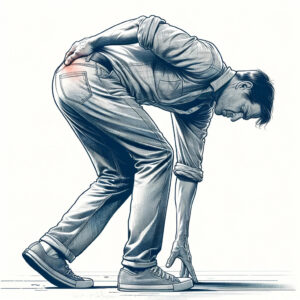Lower Back Pain and Its Misconceptions, What You Should Know !
Lower back pain is a huge problem that affects lots of people all over the world, making daily life tough for many. There’s a lot of advice out there, but also a lot of misunderstanding about what causes lower back pain and how to fix it. This post will help clear up some of those misunderstandings by showing how everything in our body is connected, which can lead us to better ways of dealing with the pain. You’ll get an idea of how I approach treating lower back pain.

Understand the Job of Your Joints/Sections of Your Body🦴
Our bodies are like well-oiled machines, with each part doing its own thing to keep us balanced and moving. Scott Hogan talks about this in his book “Built from Broken” (website). He says our ankles need to move freely to walk on different surfaces, while our knees need to be stable to hold up our upper body. Our hips need to be loose for all kinds of movements, like walking or bending, which means our lower back needs to be strong to hold up our upper body. Being able to move our upper body well is crucial for movement and breathing right. Knowing how all these parts work together helps stop lower back pain and keeps our body working well.
Do Not Focus Where the Pain Is 🎯
A lot of people try to make their lower back stronger because they think it will stop the pain. But if you don’t also work on making your hips and upper body (thoracic cage) more flexible, you might actually make things worse. This shows that just working on the sore spot isn’t enough. We need to think about our whole body to really solve the problem.
Understand How Your Spine Can Move Is Key🗝️
The spine’s ability to bend, stretch, twist, and turn is really important for how we move. Keeping our spine flexible and strong means we can do our everyday activities without pain. The best way to keep your spine happy is to use it in all the ways it can move. This includes standing up straight and making sure your feet, ankles, knees, and hips are all lined up right.
I know this might sound complicated, but it’s actually pretty straightforward. Just by being aware of how you move your body in daily activities, like walking or squatting, you can make a big difference.
TIPS FOR YOU, TO ACT ON NOW
Understanding Body Mechanics
- Stay Active Throughout the Day: Keep moving around during your day. Changing how you sit or stand and taking short walks can help keep your hips and upper back flexible.
- Incorporate Movement Variety: Do different activities that get you moving in various ways. This could be gardening, dancing, or anything that gets your whole body involved. Movement is key, so keep moving but don’t push through pain.
See instagram post for movement to get you out of sitting position

Core Engagement
- Core Engagement: Pay attention to using your core muscles during your daily activities. A strong core helps support your lower back and lowers the chance of getting hurt. Practicing deep breathing helps support your back too.
See instagram post for optimal breathing
Lifestyle Adjustments
- Ergonomic Adjustments: Change your workspace and home to make sure you’re sitting and moving in ways that don’t hurt your back. Use chairs that help keep your spine’s natural curve and make sure your screens are at the right height.
- Stress Management: Being stressed can make your muscles tense, especially around your shoulders and mid-back. Trying out deep breathing or mindfulness can help relax these muscles.
Listening to Your Body
- Recognize Pain Signals: Pay attention to your body and notice when it’s telling you something hurts. Changing how you move or taking breaks can help avoid making the pain worse. Include break every 20/30 minutes
- Hydration and Nutrition: Drink plenty of water and eat well to help your body, including your muscles and joints, work better. Be careful with coffee though—I love it too, but it can dehydrate you, so make sure it’s not all you’re drinking!
Conclusion
Getting to know the balance between moving freely and being stable helps us see lower back pain in a new way. By looking at our body as a whole, we can find better relief and improve our overall health. Remember, your spine is super important for everything you do—take good care of it!
If you have been struggling with chronic pain for too long and you are looking for a long term solution, I have been helping people with corrective exercises and functional training.
Feel free to reach out
Keep it up

Body therapist / Breath coach. Obsessed about the body. My mission is to improve life with simple and applicable way you can start acting on now.
Marginal gain baby !! Small steps … big results
